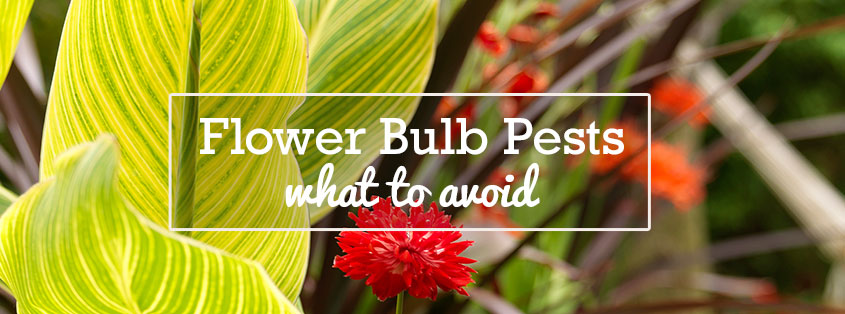FREE SHIPPING ON $45+! Code: TWHPTMH

Flower Bulb Diseases & Pests
How to Protect Flower Bulb from Pests & Diseases
Bulbs are among the easiest plants to keep healthy if you buy bulbs of good quality, rejecting any that are spotted or spongy and grow them in well- drained, fertile soil. But even under optimum conditions pests, diseases and insects sometimes strike.
Botrytis
This fungus occurs mainly in damaged or affected parts of the plants and beneath the skin between the roots. Both the bulbs and the roots beneath the skin may be infected.The symptoms of the infected bulbs are: Various bulbs are completely or partly soft and dark brown. There are large, mat black sclerotia on the diseased tissue. In the parts above the soil the infected plants are brittle and will break abruptly. The flowers have a different colour to normal ones. Heavily infected plants remain short or don’t emerge at all.
Cure: Do not plant the tulips in a purely peat-based substrate. Always mix some coarse-grain sand or disease-free soil in the peat product (20%). Give the bulbs a fungicide treatment before planting. After planting, cover the bulbs with a layer of course sand.
Green Peach Aphids
Green peach and other aphids are white to yellowish green insects about 1/8 inch long that settle on the undersides of leaves and on stems, buds and even stored bulbs. They suck the plant's juices, causing leaves to curl and flowers to become deformed. They also spread virus diseases and secrete honeydew, a sticky substance that attracts ants. More suspectible plants include dahlias, gladioluses, irises and lilies.
Cure: Knock aphids off the plants with a stream of water from a garden hose. Spray severly infested plants with malathion, rotenone or nicotine sulfate; do not neglect the undersides of leaves.
Japanese Beetles
Metallic bronze in color and 1/2 inch long, Japanese beetles chew on foliage, stems and flowers, making sizable round or irregularly shaped holes in the leaves. They are most active on warm, sunny days, when eating their way through one plant before they move on to eat the next one. Canna and dahlias are two of their favorite flowers.
Cure: Pick off beetles by hand or knock them into a can of water covered with a film of oil or kerosene. Specially designed traps are sold in garden- supply stores. Spray heavy beetle infestations with carbaryl, malathion or methoxychlor.
Wireworms
Wireworms are long, smooth, segmented larvae yellowish brown in color and up to 3/4 inch long; they develop from eggs laid in the soil by brown or black beetles known as click beetles. The larvae live entirely in the soil; they burrow into bulbs, hollowing out stems as they work their way up and causing the plant eventually to fall over. Principal targets are dahlias, gladioli and tuberous begonias.
Cure: Spray or dust the soil with diazinon or chlordane and work it into the top 6 or 8 inches of earth before planting. Set the bulbs in place, spray or dust them as well; then cover them with soil. Spray growing plants with malathion.
Botrytis Blight
Botrytis blight produces small yellow, orange, brown or reddish brown spots on leaves, flowers and bulbs, especially during rainy, humid weather. Soon the spots grow together, causing affected parts to collapse and become slimy, often with a gray and fuzzy covering of mold. Most susceptible bulbs are tulips, dahlias, gladioluses, hyacinths and tuberous begonias.
Cure: Remove any deseased plants and set new bulbs in another, wel- drained and sunny location, spacing the bulbs generously to increase air circulation and reduce humidity. Spray plants with zineb, maneb or phaltan.
Slugs
Slugs resemble shell- less snails. Fat and legless, they grow 3/4 inch to 5 inches long and may be gray , yellowish white, brown or black. They feed mostly at night, eating large, ragged holes in leaves near the ground, especially young shoots, and leaving a trail of silvery slime. Prime targets are dahlias and lilies.
Cure: Dust or spray the soil with metaldehyde or use metaldehyde pellets as bait. Leave a bowl of beer or grape juice near the plants to lure and drown the slugs. Circle the inside edge of flower beds with strips of coarse sand, cinders or ground limestone, which block the slugs' passage.
Augusta Disease
The Augusta disease is caused by the tobacco necrosis virus, which is transferred to the roots by the swarm cells of the fungus Olpidium brassicae. This is particularly encouraged by soil temperatures above 48 degrees Fahrenheit. Infected plants do not necessarily show symptoms. The disease may suddenly appear when the plants are planted out during frost. Augusta disease is most common in tulips that are planted early at high temperatures after storage on a standing ground.
Cure: Use fresh planting soil, although this is not always sufficient since the virus can survive on other plants and weeds. When using soil suspected of being diseased, do not plant the bulbs until the ambient temperature has dropped to below 9°C.